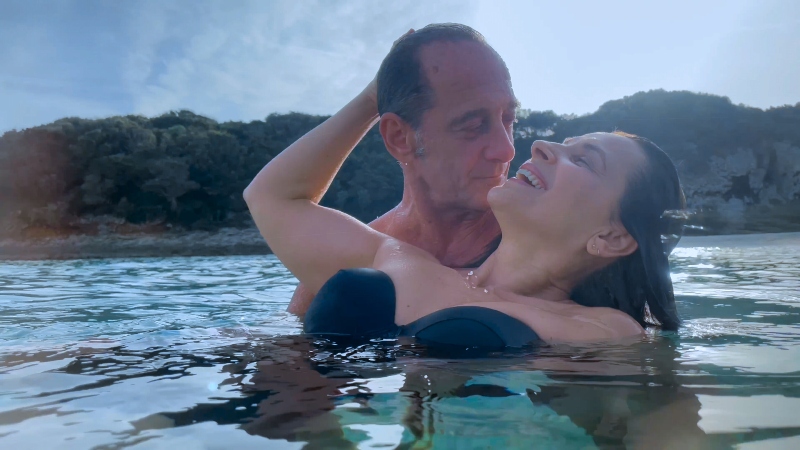
One need not be overly familiar with the work of Claire Denis to appreciate the writer-director’s impassioned new film, Both Sides of the Blade. Denis regulars Juliette Binoche and Vincent London return for a tale that plays like a lucid dream. The romantic melodrama reckons with the inevitable intersections of past and present, love and trauma.
Binoche plays Sara, a radio journalist who financially supports her ex-rugby player husband, Jean (Lindon). The film begins with the two on vacation, holding each other in the sea as they kiss. When they return to their posh, Parisian flat, they continue to kiss and end the night by having sex. Such is the style of Denis, who cleverly builds and builds this vision of their ten-year love and intimacy so that the eventual bubble-popping hits with extra force.
What at first comes across as an idyllic life reveals itself to be no more than the couple’s wishful thinking. They are not, in fact, the carefree lovers of the sea. Jean is an ex-convict and absent father to his Black son, Marcus (Issa Perica), who lives with his grandmother, Nelly (Bulle Ogier). Sara remains deeply (and secretly) in love with François (Grégoire Colin), a businessman and ex-lover whom she left for Jean. The seemingly happy couple’s lives are upended when François renters the picture. He offers Jean, his former associate, a new job and thus a fresh start. No longer will Jean feel emasculated when Sara hands him her credit card. And Sara, looking François in the face for the first time in years, is forced to reckon with repressed emotions and desires. Will she stay with Jean? Or give in to François’ overtures?
Denis, with an assist from cinematographer Eric Gautier, finds the grey areas of this love triangle and keeps her camera there, a blend of long takes with intimate close-ups, for most of the film. The introduction of François back into the lives of Jean and Sara creates ample opportunity for unfair treatment. Each takes turns hurting the other, unable to find ways of reckoning with their past together. Both Sides of the Blade takes a fatalistic view not of the past but of the refusal to deal with it.
The couple’s inability to navigate their emotionally complicated pasts are mirrored in Jean’s relationship with Marcus. In the course of the film, Marcus steals his grandmother’s credit card, nearly fails out of school and goes missing for a brief period. Denis and Christine Angot, who co-wrote the script and the novel on which the film is based, unfortunately, give far too little screen time and practically no dialogue to Marcus. Instead, Jean delivers a half-baked monologue on race to Marcus, making the character’s entire treatment feel particularly shallow.
Both Sides of the Blades take place against the backdrop of the pandemic. Masked extras fill the streets of Paris. The main characters take theirs on and off. Jean, at one moment, apologizes to his mother for forgetting his at home. Bringing the pandemic into the texture of the film is an apt choice for one that deals with the porous nature of temporality; with events that simultaneously feel of the past, present, and future. The constant presence of masked, partially-obfuscated faces feeds the dreamlike quality of the film. And they draw even more attention to the faces of Denis’ characters.
Denis’ emphasis on the face comes through in both plot and form. The characters are constantly trying to read one another. In one particularly heated moment, Jean confronts Sara, believing he witnessed her kissing François. Sara insists she pulled away from François. We in the audience witnessed her version of events, but Jean’s instance calls into question the film’s own treatment of reality. Because either way, he, she, and we in the audience know that he has lost her. So what if their lips did not actually touch?
The treatment of François deserves particular attention. Denis shoots him like a figure in a dream. The first few times we see him, he does not speak. He appears in the background, walking, often on his phone. Sometimes music plays. Sometimes he appears in a video message Jean sends to Sara. We do not hear his voice until he and Sara talk on the phone, with her looking up at him as he unknowingly looks out a window on to the street where she stands. It is when he becomes more than the periphery character of a lucid dream that Both Sides of the Blade becomes a nightmare.
At one point, near the film’s end, Jean turns to Sara and says, “I was happy, now I am not.” Such deceptively simple statements capture the essence of Denis’ filmmaking. Both Sides of the Blade is a film about the lies we tell ourselves. Of the illusions we paint to get through the day. Of the memories and feelings we repress in order to get the most out of life. Dissected, the film is a series of seemingly banal moments; the minutiae of the everyday. But together, they come to reveal the constructed nature of our own realities and how the upending of just one piece can shake the foundation beyond repair, for better, and for worse.
Both Sides of the Blade debuts in theaters on Friday, July 8, 2022.
Related Topics: Both Sides of the Blade

